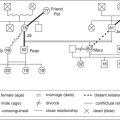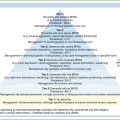Chapter 35 RATING SCALES
INTRODUCTION
Throughout this book there have been references to rating scales used to assist with assessment and to monitor and evaluate treatment. The purpose of this chapter is to provide a summary of rating scales that might make up a comprehensive battery for the mental health worker to use when caring for older people. These are only suggestions, as there are many other worthwhile instruments available in the literature. The advantages of using a rating scale include:
Some rating scales are self-report, while others require an interviewer or an informant. Some scales assess multiple domains and others assess single domains. Quite often researchers publish detailed reviews of scales and these are helpful for the clinician. For example, Neville and Byrne (2001) reviewed behaviour rating scales for older people with dementia that were suitable for use by nurses.
The rating scales chosen for this chapter are valid and reliable for use with older people in the community setting (see Table 35.1). However, if another rating scale has been identified as more appropriate for your purpose, and it has not been validated for use in the community setting, it can still be used as an indicator of functioning, rather than determining the specific cutoffs that may point to the presence or absence of a disease process. Being mindful of the nature of the workplace and workforce means that the rating scales in this chapter are brief, easy to use and require no specialist training. Before using a rating scale, it is advisable to check if permission is required and if there is a fee attached to its use.
Table 35.1 Rating scales for the assessment of older people
| Global assessment |
| Brief Psychiatric Rating Scale (BPRS) |
| General Health Questionnaire (GHQ) |
| Psychogeriatric Assessment Scales (PAS) |
| Cognitive assessment |
| Mini-Mental State Examination (MMSE) |
| Standardised Mini-Mental State Examination (SMMSE) |
| Telephone Interview for Cognitive Status (TICS–m) |
| Functional assessment |
| Activities of Daily Living (ADL) Scale |
| Instrumental Activities of Daily Living (IADL) Scale |
| Social assessment |
| Older American Resources and Services (OARS) scale |
| Behavioural and psychological symptoms of dementia |
| Dementia Behavior Disturbance Scale (DBDS) |
| Cohen-Mansfield Agitation Inventory (CMAI) |
| Crichton Visual Analogue Scale (CVAS) |
| Depression |
| Geriatric Depression Scale (GDS) |
| Cornell Scale for Depression in Dementia (CSDD) |
| Suicide |
| Beck Depression Inventory (BDI) |
| Beck Hopelessness Scale (BHS) |
| Scale for Suicidal Ideation (SSI) |
| Suicide Intent Scale (SIS) |
| Dementia |
| Consortium to Establish a Registry for Alzheimer’s Disease (CERAD) Neuropsychological Battery and Clinical Battery |
| Global Deterioration Scale (GDS) |
| Anxiety |
| Geriatric Anxiety Inventory (GAI) |
| Rating Anxiety in Dementia (RAID) |
| Substance abuse |
| CAGE questionnaire |
| Michigan Alcoholism Screening Test–Geriatric (MAST–G) |
| Impression of Medication, Alcohol, and Drug Use in Seniors (IMADUS) |
| Alcohol Use Disorders Identification Test (AUDIT) |
| Pain |
| Short-Form McGill Pain Questionnaire (SF–MPQ) |
| Abbey Pain Scale (APS) |
| Quality of life |
| Philadelphia Geriatric Center Morale Scale (PGCMS) |
| Manchester Short Assessment of Quality of Life (MANSA) |
| Dementia Quality of Life (DQoL) |
| Carer wellbeing and burden |
| Caregiver Well-Being Scale (CW–BS) |
| Caregiving Hassles Scale (CHS) |
| Burden Interview (BI) |
GLOBAL ASSESSMENT
Brief Psychiatric Rating Scale (BPRS)
The Brief Psychiatric Rating Scale (BPRS) (Overall 1974) is a clinician-rated scale that provides an assessment of common psychopathological symptoms. The primary purpose of the BPRS is to allow assessment of treatment change across a comprehensive set of common symptom characteristics. The BPRS consists of 18 items and an expanded 24-item version.
General Health Questionnaire (GHQ)
The General Health Questionnaire (GHQ) (Goldberg et al 1997) detects psychological distress and consists of four subscales: somatic symptoms; anxiety and insomnia; social dysfunction; and severe depression. It can be a self-report or administered via interview. The 28-item version is recommended and it takes 10 minutes to complete.
Psychogeriatric Assessment Scales (PAS)
The Psychogeriatric Assessment Scales (PAS) (Jorm et al 1995) are a total of six scales that assess the clinical changes that occur in dementia and depression as defined by the DSM–IV (American Psychiatric Association 2000). Three of the scales assess the older person for the domains of cognitive impairment, depression and stroke. The other three scales require an informant, and assess the domains of cognitive decline, behavioural change and stroke. The scales have good internal consistency, ranging from 0.58–0.86, and test–retest reliability between 0.47 and 0.66. Validity was established with other mood and cognitive scales. A manual accompanies the scales and administration is undertaken by a clinician or other trained person. They take 10 minutes to complete.
COGNITIVE ASSESSMENT
Mini-Mental State Examination (MMSE)
The Mini-Mental State Examination (MMSE) (Folstein et al 1975) is the best known and most widely used screening test of cognitive function in older people. It is an 11-item measure that tests five areas of cognitive function: orientation; registration; attention and calculation ability; recall; and language. A score of 24 out of 30, or lower, is generally considered to be indicative of cognitive impairment. The MMSE takes 10–15 minutes to administer by an interviewer.
Standardised Mini-Mental State Examination (SMMSE)
The Standardised Mini-Mental State Examination (SMMSE) (Molloy et al 1991) is a rating of cognitive function. It is based on the MMSE with improvements in objectivity. The SMMSE has better interrater and intrarater variance scores, and more specific instructions on scoring. This scale takes 10 minutes to complete by an interviewer.
Telephone Interview for Cognitive Status (TICS–m)
The Telephone Interview for Cognitive Status (TICS–m) (Brandt et al 1988) is an interviewer-administered scale done via the telephone, eliminating the need for an in-person assessment. It takes up to 10 minutes to complete. The TICS–m is an 11-question, 17-item test, which assesses orientation, counting, recall, calculation, repetition, knowledge, the ability to follow simple commands, and verbal reasoning. Items are scored and summed, with low TICS–m scores indicative of cognitive impairment. The TICS–m can be used for follow-up after initial MMSE assessments.
FUNCTIONAL ASSESSMENT
Activities of Daily Living (ADL) Scale
The Activities of Daily Living (ADL) Scale (Katz et al 1963) assesses levels of severe physical disability through observation or interview. It is a six-item scale that measures the older person’s ability to perform the six activities of bathing, dressing, toileting, transferring, continence and feeding unaided. If done via interview, it will take 5 minutes; however, through observation it will take much longer depending on the older person’s level of disability.
Instrumental Activities of Daily Living (IADL) Scale
The Instrumental Activities of Daily Living (IADL) Scale (Lawton 1988) assesses the functional ability of older people to perform activities that are of central importance in their everyday lives. The eight items include the ability to use the telephone, shop, prepare food, do housekeeping, do laundry, travel, take medications and handle finances. If done via interview, it will take around 5 minutes; however, through observation it will take much longer depending on the older person’s level of disability.
SOCIAL ASSESSMENT
Older American Resources and Services scale (OARS)
The Older American Resources and Services scale (OARS) (Duke University Center for the Study of Aging and Human Development 1978) is a multidimensional functional assessment questionnaire. The first part assesses level of functioning in the areas of mental health, physical health, social resources, economic resources, and activities of daily living and instrumental activities of daily living (taking medications, transferring, walking, toileting, bathing, grooming, dressing, eating, meal preparation, shopping, money management, travelling and housekeeping). The second part of the assessment determines the extent of use of and the need for services (e.g. meal delivery, domiciliary nursing care and household services). This questionnaire is very comprehensive and will take at least 40 minutes to complete. Koenig et al (1993) have developed an 11-item version, which takes considerably less time to complete.
Stay updated, free articles. Join our Telegram channel

Full access? Get Clinical Tree





